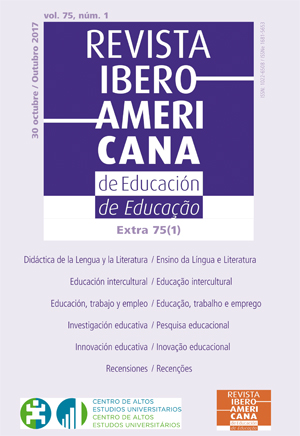La dimensión creativa en la escritura, ilustración y musicalización de cuentos del mundo
DOI:
https://doi.org/10.35362/rie7511357Palabras clave:
escritura creativa, ilustración, musicalización, cuentos del mundoResumen
El presente artículo explora la dimensión creativa de dos talleres de escritura, ilustración y musicalización de cuentos del mundo llevado a cabo con estudiantes de Pedagogía en el marco del proyecto TALIS en un campus universitario rural del nordeste de Brasil. Los objetivos principales fueron la recuperación de la memoria histórica y del patrimonio cultural de la región de Paraíba (Brasil); la formación de profesores en ejercicio y futuros profesores en nuevas metodologías docentes, en línea con los principios de la educación para el desarrollo; y la elaboración de materiales docentes creativos en formato escrito y audiovisual. Los datos recabados a través de cuestionarios, entrevistas semiestructuradas, diarios de campo, además del análisis de las producciones, mostraron una gran receptividad y un alto grado de implicación de los participantes respecto a las tres vertientes de la dimensión creativa tratadas. Asimismo, sus aportaciones contribuyeron a enriquecer el proyecto, permitiendo la incorporación de innovaciones en torno a la inclusión de nuevas temáticas, tales como la reivindicación de lugares y figuras históricas en los cuentos; y de nuevas formas de expresión, como la musicalización de los cuentos y la incorporación de la dramatización como parte integral de los talleres.
Palabras clave: escritura creativa; ilustración; musicalización; cuentos del mundo.
Descargas
Citas
Alcantud Díaz, M. & Gregori Signes, C. (2014). Audiobooks: improving fluency and instilling literary skills and education for development. Tejuelo: Didáctica de la Lengua y la Literatura, 20, 111-125.
Alvermann, D. & Phelps, S. (1998). Content reading and literacy. Boston: Allyn & Bacon.
Banks, J. A. (2001). Citizenship Education and Diversity: Implications for Teacher Education. .Journal of Teacher Education, 52(1), 5-16.
Banks, J. A. (2007). Educating Citizens in a Multicultural Society. New York: Teachers College Press.
Barron, F. (1955). The disposition toward originality. Journal of Abnormal and Social Psychology, 51, 478 –485.
Bloom, B. S. (Ed.), Engelhart, M.D., Furst, E.J., Hill, W.H., & Krathwohl, D. R. (1956). Taxonomy of educational objectives: the classification of educational goals. Handbook 1: Cognitive domain. New York: David McKay.
Carson, S. H.; Peterson, J. B. & Higgins, D. M. (2005). Reliability, Validity, and Factor Structure of the Creative Achievement Questionnaire. Creativity Research Journal, 17(1), 37-50.
Chambers, J. A. (1969). Beginning a multidimensional theory of creativity. Psychological Reports, 25(3), 779-799.
Cropley, A. J. (2001). Creativity in education and learning: A guide for teachers and educators. London: Kogan Page.
Fink, A.; Benedek, M.; Grabner, R. H.; Staudt, B. & Neubauer, A. C. (2007). Creativity meets neuroscience: Experimental tasks for the neuroscientific study of creative thinking. Methods, 42(1), 68–76.
Freire, P. (1989, 19 ed.). Educação Como Prática da Liberdade. Rio de Janeiro: Paz e Terra.
Guilford, J. P. (1950). Creativity. American Psychologist, 5, 444-454.
Guilford, J. P. (1967). The nature of human intelligence. New York: McGraw-Hill.
Haba Osca, J.; Alcantud Díaz, M. & Peredo Hernández, J. (2015). Taller de Escritura Creativa para el Desarrollo de la Competencia Literaria en Brasil. Didáctica. Lengua y Literatura, 27, 97-110.
Jones, L. (2007). The Student-Centered Classroom. Cambridge: Cambridge University Press.
Kim, K. H. (2006). Is creativity unidimensional or multidimensional? Analyses of the Torrance tests of creative thinking. Creativity Research Journal, 18(3), 251-259.
Krashen, S. (1985). The Input Hypothesis: Issues and Implications. New York: Longman.
Krathwohl, D. R. (2002). A Revision of Bloom’s Taxonomy: An Overview, Theory Into Practice, 41(4), 212-218.
Little, A. W. & Green, A. (2009). Successful globalisation, education and sustainable development. International Journal of Educational Development, 29(2), 166–174.
Lubart, T. I. (2001). Models of the Creative Process: Past, Present and Future. Creativity Research Journal, 13(3-4), 295-308.
Mace, M. A. & Ward, T. (2002). Modeling the Creative Process: A Grounded Theory Analysis of Creativity in the Domain of Art Making. Creativity Research Journal, 14(2), 179-192.
McWilliam, E.; Hearn, G. & Haseman, B. (2008). Transdisciplinarity for creative futures: what barriers and opportunities? Innovations in Education and Teaching International, 45(3), Special Issue: Creativity or conformity in higher education?
Naciones Unidas (1959). Declaration of the Rights of the Child. Proclaimed by the General Assembly, resolution 1386 (XIV), A/RES/14/1386, 20 November 1959, U.N. Doc. A/4354.
Naciones Unidas (1995). The United Nations and Human Rights. New York: Department of Public Information, United Nations.
Nussbaum, M. (2002). Education for Citizenship in an Era of Global Connection. Studies in Philosophy and Education, 21(4), 289–303.
Sadler-Smith, E. (2015) Wallas’ Four-Stage Model of the Creative Process: More Than Meets the Eye? Creativity Research Journal, 27(4), 342-352.
Sawyer, K. (2011). The Cognitive Neuroscience of Creativity: A Critical Review. Creativity Research Journal, 23(2): 137-154.
Sevilla-Pavón, A. (2015). Examining collective authorship in collaborative writing tasks through digital storytelling. European Journal of Open and Distance Learning, 18(1): 1-7. Recuperado de http://www.eurodl.org/?p=current&sp=brief ISSN: 1027-5207.
Srinivasan, N. (2007). Cognitive neuroscience of creativity: EEG based approaches. Methods, 42(1), 109–116.
Todd I. L. (2001) Models of the Creative Process: Past, Present and Future. Creativity Research Journal, 13(3-4), 295-308.
UNESCO (2007). The UN Decade for Education for Sustainable Development (DESD 2005–2014): the first two years. Paris: UNESCO.
UNICEF (1993). Programa de aprendizaje permanente. Bruselas: UNICEF.
Vygotsky, L. (1978). Mind and Society. Cambridge: Harvard University Press.
Wallas, G. (1970): The art of thought. En: Vernon, P.E. (Ed.): Creativity (pp. 91-97, publicación original: 1926, The Art of Thought. New York: Harcourt-Brace). Harmondsworth, Middlesex: Penguin.
Cómo citar
Publicado
Número
Sección
Licencia
Aquellos autores/as que tengan publicaciones con esta revista, aceptan los términos siguientes:















